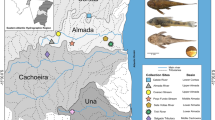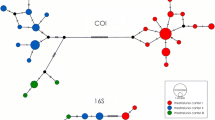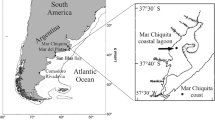Abstract
The current taxonomic status of Sotalia species is uncertain. The genus once comprised five species, but in the twentieth century they were grouped into two (riverine Sotalia fluviatilis and marine Sotalia guianensis) that later were further lumped into a single species (S. fluviatilis), with marine and riverine ecotypes. This uncertainty hampers the assessment of potential impacts on populations and the design of effective conservation measures. We used mitochondrial DNA control region and cytochrome b sequence data to investigate the specific status of S. fluviatilis ecotypes and their population structure along the Brazilian coast. Nested-clade (NCA), phylogenetic analyses and analysis of molecular variance of control region sequences showed that marine and riverine ecotypes form very divergent monophyletic groups (2.5% sequence divergence; 75% of total molecular variance found between them), which have been evolving independently since an old allopatric fragmentation event. This result is also corroborated by cytochrome b sequence data, for which marine and riverine specimens are fixed for haplotypes that differ by 28 (out of 1,140) nucleotides. According to various species definition methods, we conclude that marine and riverine Sotalia are different species. Based on priority criteria, we recommend the revalidation of Sotalia guianensis (Van Bénéden 1864) for the marine animals, while riverine dolphins should retain the species name Sotalia fluviatilis (Gervais 1853), thus becoming the first exclusively riverine delphinid. The populations of S. guianensis show a strong subdivision (ΦST=0.628) along the Brazilian coast, with at least three evolutionarily significant units: north, northeastern and south/southeastern.





Similar content being viewed by others
References
Amos B, Hoelzel AR (1991) Long-term preservation of whale skin for DNA analysis. In: Hoelzel AR, Donovan GP (eds) Genetic ecology of whales and dolphins—Rep IWC, Special Issue 13. International Whaling Commission, Cambridge, pp 99–104
Avise JC (1997) Conservation genetics in the marine realm. J Hered 89:377–382
Avise JC (2004) Molecular markers, natural history and evolution, 2nd edn. Chapman & Hall, New York
Baker SC, Perry A, Bannister JL, Weinrich MT, Abernethy RB, Calambokidis J, Lien J, Lambertsen RH, Úrban Ramírez J, Vasquez O, Clapham PJ, Alling A, O’Brien SJ, Palumbi SR (1993) Abundant mitochondrial DNA variation and world-wide population structure in humpback whales. Proc Natl Acad Sci USA 90:8239–8243
Banguera-Hinestroza E, Cárdenas H, Ruiz-García M, Marmontel M, Gaitán E, Vasquez R, García-Vallejo (2002) Molecular identification of evolutionarily significant units in the Amazon river dolphin Inia sp. (Cetacea: Iniidae). J Hered 93:312–322
Borobia M (1989) Distribution and morphometrics of South American dolphins of the genus Sotalia. M.Sc. thesis, McGill University, Canada, 81pp
Borobia M, Siciliano S, Lodi L, Hoek W (1991) Distribution of the South-American dolphin Sotalia fluviatilis. Can J Zool 69:1025–1039
Cabrera A (1961) Catalogo de los mamiferos de America del Sur II (Sirenia–Perissodactyla–Artiodactyla–Lagomorpha–Rodentia–Cetacea) Rev Mus Argentino Ciênc Natural Bernardino Rivadavia, Ciências Zoológicas 4:309–732
Carvalho CT (1963) Sobre um boto comum no litoral do Brasil (Cetacea, Delphinidae). Rev Bras Biol 23:263–276
Cipriano F (1997) Antitropical distributions and speciation in dolphins of the genus Lagenorhynchus: a preliminary analysis. In: Dizon AE, Chivers SJ, Perrin WF (eds) Molecular genetics of marine mammals, Special publication no. 3. The Society for Marine Mammalogy, Lawrence, pp 305–316
Clement M, Posada D, Crandall KA (2000) TCS: a computer program to estimate gene genealogies. Mol Ecol 9:1657–1659
Crandall KA, Templeton AR (1993) Empirical tests of some predictions from coalescent theory with applications to intraspecific phylogeny reconstruction. Genetics 134:959–969
Crandall KA, Bininda-Emmonds ORP, Mace GM, Wayne RK (2000) Considering evolutionary processes in evolutionary biology. Trends Ecol Evol 15:290–295
Dalebout ML, Mead JG, Baker SC, Baker A, van Helden L (2002) A new species of beaked whale discovered through phylogenetic analyses of mitochondrial DNA sequences. Mar Mamm Sci 18:577–608
da Silva VMF, Best RC (1996) Sotalia fluviatilis. Mamm Species 527:1–7
Di Beneditto APM, Ramos R (2004) Biology of the marine tucuxi dolphin (Sotalia fluviatilis) in south-eastern Brazil. J Mar Biol Assoc UK 84:1245–1250
Dizon AE, Lockyer C, Perrin WF, Demaster DP, Sisson J (1992) Rethinking the stock concept: a phylogeographic approach. Conserv Biol 6:24–36
Dizon AE, Perrin WF, Amos W, Baker CS, Chivers SJ, Costa AS, Curry BE, Gaggiotti O, Hoelzel AR, Hofman R, LeDuc RG, Loughlin TR, Lux CA, O’Corry-Crowe GM, Rosel PE, Rosenberg A, Scribner KT, Taylor BL (1997) Report of the Workshop. In: Dizon AE, Chivers SJ, Perrin WF (eds) Molecular genetics of marine mammals, Special publication no. 3. The Society for Marine Mammalogy, Lawrence, pp 3–48
Excoffier L, Smouse PE, Quattro JM (1992) Analysis of molecular variance inferred from metric distances among DNA haplotypes: application to human mitochondrial DNA restriction data. Genetics 131:479–491
Flores PAC (2002) Tucuxi—Sotalia fluviatilis. In: Perrin WF, Würsig B, Thewissen JGM (eds) Encyclopedia of marine mammals. Academic, San Diego, pp 1267–1269
Gervais P (1853) Remarques sur les mammifères marins qui frequentent les côtes de la France et plus particulièrement sur une nouvelle espèce de Dauphin propre à la Méditerranée. Bull Soc Centr Agricult comices agric départ l’Herault (Montpellier), 40 année (Avril, Main, Juin):140–156
Hare MP, Cipriano F, Palumbi SR (2002) Genetic evidence on the demography of speciation in allopatric dolphin species. Evolution 56:804–816
Harlin AD, Markowitz T, Baker CS, Würsig B, Honeycutt RL (2003) Genetic structure, diversity, and historical demography of New Zealand’s dusky dolphin (Lagenorhynchus obscurus). J Mammal 84:702–717
Hayano A, Yoshioca M, Tanaka M, Amano M (2004) Population differentiation in the Pacific white-sided dolphin (Lagenorhynchus obliquidens) inferred from mitochondrial DNA and microsatellite analyses. Zool Sci:989–999
Hershkowitz PH (1966) Catalog of living whales. US Nat Mus Bull 246:18–22
Hoelzel AR, Hancock JM, Dover G (1991). Evolution of the cetacean mitochondrial D-loop region. Mol Biol Evol 8:475–493
Hoorn C, Guerrero J, Sarmiento GA, Lorente MA (1995) Andean tectonics as a cause for changing drainage patterns in Miocene northern South America. Geology 23:237–240
IBAMA (1997) Mamíferos Aquáticos do Brasil: Plano de Ação. IBAMA, Brasília
IBAMA (2001) Mamíferos Aquáticos do Brasil: Plano de Ação (versão II). IBAMA, Brasília
Irwin DM, Kocher TD, Wilson AC (1991) Evolution of the cytochrome b gene of mammals. J Mol Evol 32:128–144
Jefferson TA, Leatherwood S, Weber MA (1993) Marine mammals of the world—FAO species identification guide. FAO, Rome
Klammer G (1984) The relief of the extra-Andean Amazon basin. In: Sioli H (ed) The Amazon: limnology and landscape ecology of a mighty tropical river and its basin. Dr W Junk Publisher, Dordrecht, pp 47–83
Knowlton N (2000) Molecular genetic analyses of species boundaries in the sea. Hydrobiologia 420:73–90
Kocher TD, Thomas WK, Meyer A, Edwards SV, Pääbo S, Villablanca FX, Wilson AC (1989) Dynamics of mitochondrial DNA evolution in animals: amplification and sequencing with conserved primers. Proc Natl Acad Sci USA 86:6196–6200
Kumar S, Tamura K, Jakobsen IB, Nei M (2001) MEGA 2.1: Molecular Evolutionary Genetics Analysis software. Bioinformatics 17:1244–1245
Lailson-Brito J Jr, Kehrig HA, Malm O (2002) Mercúrio total nos tecidos do boto-cinza, Sotalia fluviatilis (Cetacea, Delphinidae), da Baía de Guanabara, Rio de Janeiro. In: Prego R, Duarte A, Panteleitchouk AV, Santos TR (eds) Estudos sobre Contaminação Ambiental na Península Ibérica. Editora Piaget, Portugal, pp 302
Le Duc RG, Perrin WF, Dizon AE (1999) Phylogenetic relationships among delphinid cetaceans based on full cytochrome b sequences. Mar Mamm Sci 15:619–648
Leatherwood S, Reeves RR (1983) The Sierra Club handbook of whales and dolphins. Sierra Club Books, San Francisco
Lesson RP (1828) Histoire Naturelle, Générale et Particulière des Mammifères et des Oiseaux Découverts depuis 1788 jusqu’à nos Jours. Complément des oeuvres de Buffon, ou historie naturelle des animaux rares découverts par les naturalistes et les voyageurs depuis la mort de Buffon. Tom. 1 Cétacés. Baudoin Frères, Paris, 442pp
Lundberg JG, Marshall LG, Guerrero J, Horton B, Malabarba MCSL, Wesselingh F (1998) The stage for Neotropical fish diversification: a history of tropical South American rivers. In: Malabarba LR, Reis RE, Vari RP, Lucena ZM, Lucena CAS (eds) Phylogeny and classification of Neotropical fishes. Edipucrs, Porto Alegre, Brasil, pp 603
Mitchell ED (1975) Report of the meeting on smaller cetaceans. J Fish Res Board Can 32:889–983
Monteiro-Filho ELA, Monteiro LR, Reis SF (2002) Skull shape and size divergence in dolphins of the genus Sotalia: a tridimensional morphometric analysis. J Mammal 83:125–134
Muller-Karger FE, McClain CR, Richardson PL (1988) The dispersal of the Amazon’s water. Nature 333:57–59
Natoli A, Peddemors VM, Hoelzel AR (2004) Population structure and speciation in the genus Tursiops based on microsatellite and mitochondrial DNA analyses. J Evol Biol 17:363–375
Nei M (1987) Molecular evolutionary genetics. Columbia University Press, New York
O’Brien SJ (1994) A role for molecular genetics in biological conservation. Proc Natl Acad Sci USA 91:5478–5755
Palsbøll P, Vader A, Bakke I, El-Gewely R (1992) Determination of gender in cetaceans by the polymerase chain reaction. Can J Zool 70:2166–2170
Palumbi SA, Martin A, Romano S, McMillan WO, Stice L, Grabowski G (1991) The simple fool’s guide to PCR Version. 2.0. University of Hawaii, Hawaii
Parsons KM, Noble LR, Reid RJ, Thompson PM (2002) Mitochondrial genetic diversity and population structuring of UK bottlenose dolphins (Tursiops truncatus): is the NE Scotland population demographically and geographically isolated? Biol Conserv 108:175–182
Pichler FB, Baker CS (2000) Loss of genetic diversity in the endemic Hector’s dolphin due to fisheries-related mortality. Proc R Soc Lond B 267:97–102
Pichler FB, Dawson SM, Slooten E, Baker CS (1998) Geographic isolation of Hector’s dolphin populations described by mitochondrial DNA sequences. Conserv Biol 12:676–682
Posada D, Crandall KA (1998) Modeltest: testing the model of DNA substitution. Bioinformatics 14:817–818
Posada D, Crandall KA (2001) Intraspecific gene-genealogies: trees grafting into networks. Trends Ecol Evol 16:37–45
Posada D, Crandall KA, Templeton AR (2000) GeoDis: a program for the cladistic nested analysis of the geographical distribution of genetic haplotypes. Mol Ecol 9:487–488
Reeves RR, Smith BD, Crespo EA, Notarbartolo Di Sciara G (2003) Dolphins, whales and porpoises: 2002–2010 Conservation Action Plan for the World’s Cetaceans. IUCN/SSC Cetacean Specialist Group. IUCN, Gland, Switzerland and Cambridge, UK
Reeves RR, Perrin WF, Taylor BL, Baker SC, Mesnick SL (2004) Report of the workshop on shortcomings of cetacean taxonomy in relation to needs of conservation and management. La Jolla, CA, USA. NOAA Technical Memorandum NOAA-NMFS-SWFSC-363
Rice DW (1998) Marine mammals of the world—systematics and distribution. Special Publ No. 4, The Society for Marine Mammalogy, Lawrence, USA
Rosas FCW, Barreto AS, Monteiro-Filho ELA (2003) Age and growth of the estuarine dolphin (Sotalia guianensis) (Cetacea: Delphinidae) on the Paraná coast, southern Brazil. Fish Bull 101:377–383
Rosel PE, Rojas-Bracho L (1999) Mitochondrial DNA variation in the critically endangered vaquita Phocoena sinus Norris and MacFarland 1958. Mar Mamm Sci 15:990–1003
Rosel PE, Dizon AE, Heyning JE (1994) Genetic analysis of sympatric morphotypes of common dolphins (genus Delphinus). Mar Biol 119:159–167
Rozas J, Sánchez-DelBarrio JC, Messenguer X, Rozas R (2003) DNA SP, DNA polymorphism analyses by the coalescent and other methods. Bioinformatics 19:2496–2497
Sambrook J, Fritsch EF, Maniatis T (1989) Molecular cloning: a laboratory manual. Cold Spring Harbor Laboratory Press, Cold Spring harbour, NY
Santos MCO, Rosso S, Ramos RMA (2003) Age estimation of marine tucuxi dolphins (Sotalia fluviatilis) in south-eastern Brazil. J Mar Biol Assoc UK 83:233–236
Schneider S, Roessli D, Excoffier L (2000) Arlequin ver 2000: a software for population genetic data analysis. Genetics and Biometry Laboratory, University of Geneva, Switzerland
Siciliano S (1994) Review of small cetaceans and fishery interactions in coastal waters of Brazil. In: Hoelzel AR, Donovan GP (eds) Rep IWC, Special Issue 15. International Whaling Commission, Cambridge, pp 241–250
Sites JW, Marshall JC (2003) Delimiting species: a renaissance issue in systematic biology. Trends Ecol Evol 18:462–470
Swofford DL (2002) PAUP*. Phylogenetic analysis using parsimony (* and other methods). Version 4. Sinauer Associates, Sunderland, MA, USA
Taylor BL, Rojas-Bracho L (1999) Estimating the risk of inbreeding depression in a naturally rare cetacean, the vaquita (Phocoena sinus). Mar Mamm Sci 15:1004–1028
Templeton AR (1998) Nested clade analyses of phylogeographic data: testing hypotheses about gene flow and population history. Mol Ecol 7:381–397
Templeton AR (2001) Using phylogeographic analyses of gene trees to test species status and processes. Mol Ecol 10:779–791
Templeton AR (2004) Inference key for the nested haplotype tree analysis of geographical distances. Available at http://darwin.uvigo.es/software/geodis.html, since July 14, 2004
Templeton AR, Crandall KA, Sing CF (1992) A cladistic analysis of phenotypic associations with haplotypes inferred from restriction endonuclease mapping and DNA sequence data. III. Cladogram estimation. Genetics 132:619–633
True EW (1889) Review of the Family Delphinidae. US Nat Mus Bull 36:17–21
van Bénéden E (1864) Sur un dauphin nouveau et un ziphiode rare. Memm l’Acad Royale Sci Belgique 41:2–44
van Bree PJH (1974) On the diagnosis of the South American dolphin Sotalia fluviatilis and its authorship. Z Säugetierkd 39:57–58
Wada S, Oishi M, Yamada TK (2003) A newly discovered species of living baleen whale. Nature 426:278–281
Wang JY, Chou LS, White BN (1999) Mitochondrial DNA analysis of sympatric morphotypes of bottlenose dolphins (genus: Tursiops) in Chinese waters. Mol Ecol 8:1603–1612
Acknowledgements
We thank Priscila Medeiros, Maria Emília Yamamoto, Coleção de Mamíferos do INPA and REMANE/CMA/IBAMA (Rede de Encalhes de Mamíferos Aquáticos do Nordeste/Centro de Mamíferos Aquáticos/IBAMA) for providing tissue samples. The staff of Lab de Biodiversidade Molecular (Jaqueline Gusmão, Cristiano Lazoski, Daíza Lima, Renata Schama and Carla Zilberberg) greatly contributed with lab work. We are thankful to Lena Geise, who granted access to important bibliography, and to Carolina Voloch, who drew the map. We are also indebted to Nancy Knowlton, for suggestions to the manuscript. This work was financially supported by CNPq and FAPERJ, and is part of HAC’s doctorate thesis. Biopsy was authorized under permits 022-01/CMA/IBAMA, 005-04/CMA/IBAMA, 002-01/CMA/IBAMA, 012-03/CMA/IBAMA and IBAMA 02001.0002344/96-11. Genetic analyses were performed under permit 03/2005-IBAMA.
Author information
Authors and Affiliations
Corresponding author
Additional information
Communicated by J. P. Thorpe, Port Erin
Rights and permissions
About this article
Cite this article
Cunha, H., da Silva, V., Lailson-Brito, J. et al. Riverine and marine ecotypes of Sotalia dolphins are different species. Marine Biology 148, 449–457 (2005). https://doi.org/10.1007/s00227-005-0078-2
Received:
Accepted:
Published:
Issue Date:
DOI: https://doi.org/10.1007/s00227-005-0078-2




